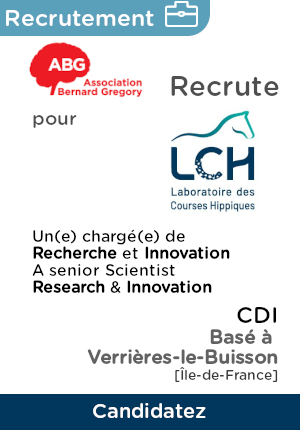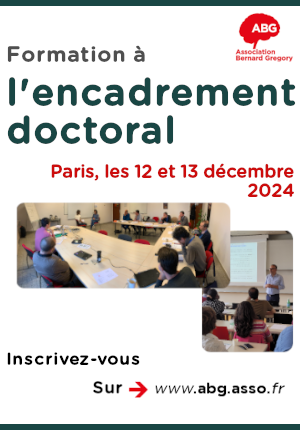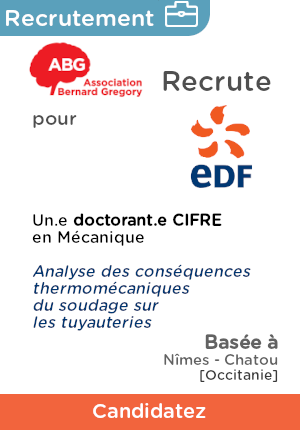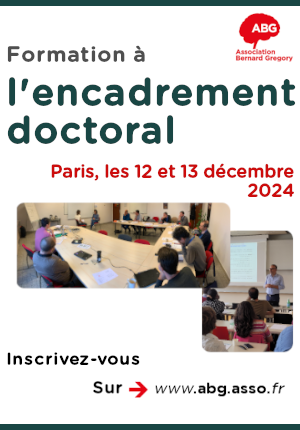Low-frequency wireless power transfer based on nonlinear electromechanical antennas
| ABG-124865 | Sujet de Thèse | |
| 01/07/2024 | Autre financement public |
- Sciences de l’ingénieur
- Physique
- Sciences de l’ingénieur
Description du sujet
Keywords
Nonlinear dynamics, Mechanical design, Wireless power transfer, Multiphysics, Electromechanical resonator, Nonlinear resonances, Piezoelectricity
Context
Wireless power transfer (WPT) systems are used to transfer electrical energy without cables from a transmitter to a receiver to power an end-device (e.g., sensors, actuators, or low-power processing units). Such systems are particularly relevant for powering Internet of Things (IoT) devices when using cables appear too costly, complex, or hazardous [1]. In a generic WPT system, the emitter converts electrical energy sent from the source to an intermediate form of energy (i.e., magnetic, mechanical, radiative, electrostatic …), in the aim of wirelessly transferring this energy through a transmission medium (i.e., air, metal, water …). On the receiver side, the energy is converted back to electricity to supply the load.
Various modern applications involve powering systems through conductive media, such as water, metal walls and boxes, and biological tissues. As an example, implantable biomedical sensors and actuators developed for modern medicine purposes(e.g., insulin pumps, glucose sensors, artificial neurotransmitters) require transmitting power through the human body, which is a complex medium mainly composed of water, and eventually through the package of the sensor which can be metallic and therefore conductive. In such applications, the high frequency of traditional WPT systems has many drawbacks: high absorption by the conductive media (water of the human body, metallic shell around the sensor) due to eddy currents leading to poor transmission distance and power, radiation hazard due to human tissue absorption of the high-frequency magnetic waves, large increase of the receiver size required to decrease the resonant frequency, etc. As an illustration, a 1mm thick aluminum sheet attenuates the amplitude of a 1MHz electromagnetic wave by a factor of about 106.
Detailed subject
ONEFOLD project, supported by the French national research agency, under grant number ANR-23-CE51-0007, aims at exploring an emerging solution for power transmission at very low frequencies, based on Electrodynamic wireless power transfer. In electrodynamic WPT system, the emitter consists of a transmitting coil powered by a low-frequency current that generates a low-frequency (<100 Hz) magnetic field that is weakly absorbed by conductive media. This magnetic field sets in motion a moving magnet attached to a mechanical resonator with a low resonant frequency. The oscillation of this resonator is converted back into electrical energy using, for instance, a piezoelectric transducer. Electrodynamic WPT solutions offer high power density and low-frequency (50-1000 Hz) WPT options and are particularly effective for transmitting power through conductive media. They can achieve ten to hundreds of times higher power density than state-of-the-art low-frequency inductive WPT solutions for greater transmission distances through conductive media [2, 3].
In ONEFOLD, we propose to explore, size and optimize nonlinear electromechanical receiver for converting the magnetic field back to electricity. Nonlinear resonators will optimize receiver operation at ultra-low frequencies, with small volumes and low sensitivity to frequency shifts. Various exotic behaviors emerging due to the receiver nonlinearity, such as superharmonicsregimes, chaos, or softening resonances, could be further exploited to design optimized receiver and propose new openings for efficient wireless power transfer through conductive media.
Objective 1 – Explore nonlinear dynamics to maximize power transmission to nonlinear receivers. We aim to investigate, both theoretically and experimentally, how nonlinear behaviors and resonances can be leveraged to maximize the power density of nonlinear receivers. In the first part of the project, we will analyze how various resonances and orbits of bistable nonlinear resonators can be exploited to achieve this goal. In the second part of the project, we will explore how other types of nonlinearities can be engineered to maximize the receiver power density. Fundamental questions, such as the relevance of exploiting nonlinear resonances, the optimality of softening and superharmonic behaviors, and the optimal potential well shapes for maximizing power density, will be answered.
Objective 2 – Design and fabricate high power-density (>10 mW/cm3) receivers for wirelessly transmitting power (10 mW – 1 W for distances between 1 cm to 30 cm) through conductive media at near-DC frequencies (< 20 Hz), with system-level constraints. We will design and fabricate optimal receivers based on a global electromechanical optimization of the whole system, using nonlinear reduced-order models. This optimization will identify optimal geometrical dimensions for the resonator, the optimal emitting waveform, and the optimal circuitry connected to the receiver. To implement the optimal nonlinear resonator and shape its potential wells, we will fabricate new nonlinear prototypes based on mechanical buckling of beams or magnetic interactions. Finally, the optimal solutions proposed in this project will be compared against traditional WPT technologies described in the literature.
The long-term objective is to pave to way to a new category of nonlinear electrodynamics receivers for WPT systems, with reduced operating frequency, higher power density, and better efficiency for transmitting power through conductive media, compared to traditional WPT solutions. This will be allowed by bridging the gap between, on the one hand, nonlinear dynamics modeling and system optimization, and, on the other hand, mechanical design and fabrication.
Tasks percentages estimation:
Literature review: 5%
Multiphysics modeling and simulation with analytical and numerical tools: 20%
Mechanical fabrication: 15%
Experimental tests, measurements, and data processing: 15%
Nonlinear dynamics exploration, understanding, and exploitation: 30%
Scientific dissemination and manuscript writing: 15%
Prise de fonction :
Nature du financement
Précisions sur le financement
Présentation établissement et labo d'accueil
Location
The PhD thesis will fully take place at SYMME (Systems and Materials for Mechatronics) laboratory, Annecy, France. The selected candidate will be integrated in the micro-energies team of the laboratory, that has expertise on micro energies transfer, conversion, and collection.
https://www.univ-smb.fr/symme/themes/recuperation-conversion-et-transmission-denergie/
Intitulé du doctorat
Pays d'obtention du doctorat
Etablissement délivrant le doctorat
Profil du candidat
Candidate profile
The candidate should have or be about to obtain an Msc in Mechanical Engineering, dynamics, physics, or mechatronics. She/he must have an interest in applied mathematics (analytical modeling, optimization algorithms, nonlinear ODE analysis), mechanical engineering (linear and nonlinear resonators, FEM simulations, prototypes fabrication), and multiphysics (electromagnetism, electromechanical systems, piezoelectricity). It is obviously not required for the candidate to be already familiar with all of these topics, but she/he must be motivated and interested to investigate all aspects.
Analytical as well as experimental skills are mandatory. Knowledge of programming/computing language (MATLAB/Simulink, Mathematica and/or Python), FEM softwares (Comsol and/or Ansys) would be a plus. Excellent written and verbal communication skills in English is required. Fluency in French is also a plus, but is not mandatory.
Vous avez déjà un compte ?
Nouvel utilisateur ?
Vous souhaitez recevoir nos infolettres ?
Découvrez nos adhérents
 ONERA - The French Aerospace Lab
ONERA - The French Aerospace Lab  Groupe AFNOR - Association française de normalisation
Groupe AFNOR - Association française de normalisation  ANRT
ANRT  MabDesign
MabDesign  Ifremer
Ifremer  SUEZ
SUEZ  CASDEN
CASDEN  Nokia Bell Labs France
Nokia Bell Labs France  CESI
CESI  Généthon
Généthon  MabDesign
MabDesign  PhDOOC
PhDOOC  Laboratoire National de Métrologie et d'Essais - LNE
Laboratoire National de Métrologie et d'Essais - LNE  TotalEnergies
TotalEnergies  Tecknowmetrix
Tecknowmetrix  Institut Sup'biotech de Paris
Institut Sup'biotech de Paris  Aérocentre, Pôle d'excellence régional
Aérocentre, Pôle d'excellence régional  Institut de Radioprotection et de Sureté Nucléaire - IRSN - Siège
Institut de Radioprotection et de Sureté Nucléaire - IRSN - Siège  ADEME
ADEME
-
EmploiCDIRef. ABG123642Laboratoire des Courses Hippiques (GIE LCH)Verrières-le-Buisson - Ile-de-France - France

Chargé(e) de Recherche et Innovation (H/F) / Senior Scientist Research & Innovation (M/F)
Chimie - BiochimieConfirmé -
EmploiCDIRef. ABG124941Corteria PharmaceuticalsMassy-Palaiseau - Ile-de-France - France

Jeune Docteur, Chercheur en Biologie Cellulaire & Moléculaire (H/F)
BiologieNiveau d'expérience indifférent -
EmploiCDDRef. ABG125071KTHStockholm - Suède
ERC-funded postdoc position on the detection of gas-phase organic radicals, KTH, Stockholm, Sweden
Chimie - Physique - Sciences de l’ingénieurNiveau d'expérience indifférent












